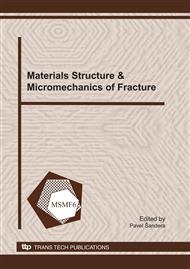p.342
p.346
p.350
p.354
p.358
p.362
p.366
p.370
p.374
Mechanical Behaviour and Microstructure Evolution of Eurofer97 during Low-Cycle Fatigue at Room Temperature and 550°C
Abstract:
The cyclic behaviour of the steel EUROFER 97 during isothermal plastic strain-controlled tests was investigated at room temperature and at 550°C. Under these test conditions, the steel shows, after the first few cycles, a cyclic softening following a power-law function that continues up to failure. The rate of softening increases with temperature, being very pronounced at temperatures above 500°C. The evolution of the flow stress during cycling was studied by analyzing the so-called “back” and “friction” stresses obtained from the hysteresis loops measured along the entire test. From the analysis of the hysteresis loops and corroborated by electron microscopy observations, it can be concluded that the strong cyclic softening observed on these samples with a "tempered martensite" structure is produced by the softening exhibited by both stresses. However, the importance of each of these stresses on the softening depends on the applied strain amplitude and temperature. It was observed that, at low temperatures and applied strains, the friction stress shows the strongest influence on the cyclic softening. On the contrary, at higher temperatures and applied strains the back stress reveals the most important changes occurring in the interior of the material.
Info:
Periodical:
Pages:
358-361
Citation:
Online since:
January 2011
Authors:
Keywords:
Price:
Сopyright:
© 2011 Trans Tech Publications Ltd. All Rights Reserved
Share:
Citation:


